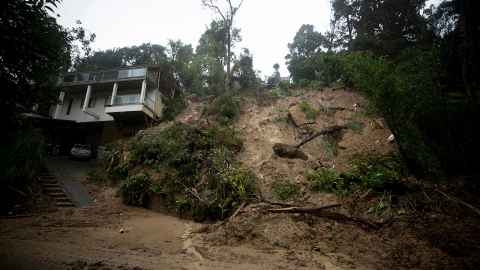Cyclone Gabrielle an opportunity for extra geography lessons
1 March 2023
Opinion: Professor John Morgan says there are plenty of lessons to be learned for adults after recent severe weather events, but also to share with children in the classroom.

Now that Auckland schools are back to some sort of normality, geography teachers have an opportunity to give students some timely lessons on recent weather events.
Auckland’s ‘state of emergency’ – the floods and landslides that have affected the city and its region, and which will have consequences for years to come – demand a geographical explanation.
I admit I have skin in the game. I am a geography teacher, but I also spent five days trapped behind a sizeable landslide that blocked access to and from my home in Titirangi. I went nowhere for a while. The surrounding hills are scarred by landslides – some big, some small – and the habitual scrolling of social media brought fresh evidence of the effect of this huge weather event.
A flood like the one on 27 January has happened before. In April 2017, I woke to the sound of trees being snapped by a landslide; that time it was small drain at the top of the slope that couldn’t cope with the water coming from the hills above. When the downpour came, the ground was sodden, and the clay started to slide.
I have had a lot of time to look at and think about this landscape, and the word that keeps coming to mind is ‘Anthroposcene’, a term coined by geographer David Matless to describe a “landscape emblematic of processes marking the Anthropocene”.
The Anthropocene is the term many geologists propose to describe the fact that we live in a new epoch, one in which human activity is changing the Earth’s systems – its climate, its soils, its flow of water and so on.
There is controversy about this, it hardly needs saying. Is there water-tight (forgive the pun) evidence that the climate is changing? Is it fair to blame all people (Anthros) when clearly some cause more problems than others? There’s plenty to debate, but what children need is a chance to explore what might be happening to their city in the context of these big processes. The one thing we can say for sure is that this is a human rather than natural disaster.
Most of us know that removing trees to build houses or building houses on
floodplains is not ideal, so why are we compelled to do it anyway?”
Here’s my ‘lesson plan’.
The first and obvious question is whether what is happening in Auckland can be attributed to human-induced climate change? Children often think in ‘either/or’ terms, and we could never ‘prove’ that the intense rainfall is a direct effect of a changing climate. But looking at storm frequency and intensity, and abnormal weather patterns across the globe, puts what has happened into context.
Coming down to earth, the next thing is to understand what happens to all that rainfall when it hits the ground. Children are taught early that it ends up in rivers and to the sea, before being recycled into the atmosphere.
But we need a more detailed picture of the water cycle. At what rates does water travel through the landscape, and through what pathways? Contrary to the views of one Facebook post, trees don’t cause floods. The opposite: they act as a sponge, soaking up rainfall and releasing it slowly.
Different land surfaces and soil types are permeable, pervious or impermeable. What about concrete drives and road surfaces? A key concept is that of ‘antecedent moisture condition’ or the state of the ground before the storms.
Once we have a basic model of the physical geography, we can get into the question of how decisions people have made are involved in these events. After all, most of us know that removing trees to build houses or building houses on floodplains is not ideal, so why are we compelled to do it anyway? Why, across our city, do we increase housing density by sub-dividing property? Thinking of where I live, why, about 100 years ago, was native vegetation removed for farmland, and why has that farmland since been converted to residential areas?
Starting local invariably leads to wider questions, applicable to other cities and places. How are cities like Auckland encouraged to grow in actual and population size? Is the promotion of Auckland as a global city compatible with the government’s well-being agenda? How ‘liveable’ is our city now? And, most important of all, are there ways to prevent this happening again?
To finish these ‘lessons’, we should encourage children to think wild thoughts about how to re-imagine Auckland’s geography. After all, many of them will go on to live in this place. Geography teachers can’t be smug. In many ways, the ‘Anthropocene’ I have been surveying from behind the landslide reflects the failure of geographical education.
Geography should have helped generations of citizens and politicians to understand the complex ways in which environment and economy are related, and how short-term gains in property value or economic growth can easily be swept away by processes that take decades and even centuries to work through.
It is not too late to educate the next generation. Let’s start today.
Professor John Morgan is Head of School, Critical Studies in Education. This March 2023 UniNews piece is adapted from an article first published on Newsroom.